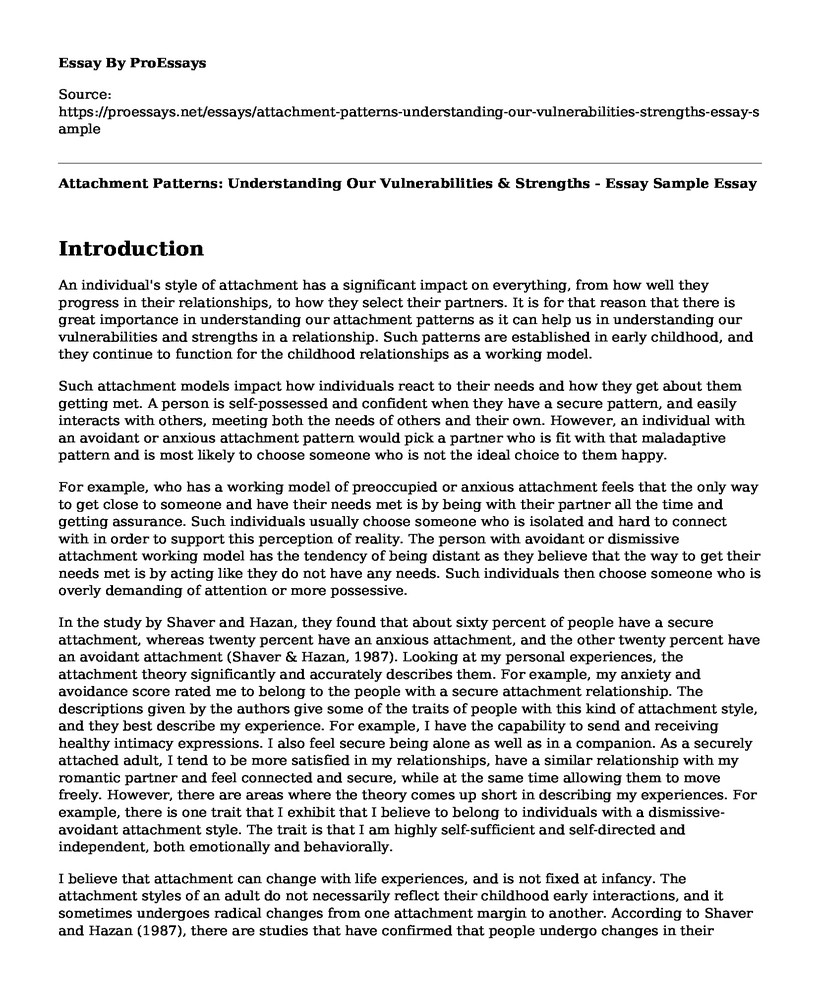Introduction
An individual's style of attachment has a significant impact on everything, from how well they progress in their relationships, to how they select their partners. It is for that reason that there is great importance in understanding our attachment patterns as it can help us in understanding our vulnerabilities and strengths in a relationship. Such patterns are established in early childhood, and they continue to function for the childhood relationships as a working model.
Such attachment models impact how individuals react to their needs and how they get about them getting met. A person is self-possessed and confident when they have a secure pattern, and easily interacts with others, meeting both the needs of others and their own. However, an individual with an avoidant or anxious attachment pattern would pick a partner who is fit with that maladaptive pattern and is most likely to choose someone who is not the ideal choice to them happy.
For example, who has a working model of preoccupied or anxious attachment feels that the only way to get close to someone and have their needs met is by being with their partner all the time and getting assurance. Such individuals usually choose someone who is isolated and hard to connect with in order to support this perception of reality. The person with avoidant or dismissive attachment working model has the tendency of being distant as they believe that the way to get their needs met is by acting like they do not have any needs. Such individuals then choose someone who is overly demanding of attention or more possessive.
In the study by Shaver and Hazan, they found that about sixty percent of people have a secure attachment, whereas twenty percent have an anxious attachment, and the other twenty percent have an avoidant attachment (Shaver & Hazan, 1987). Looking at my personal experiences, the attachment theory significantly and accurately describes them. For example, my anxiety and avoidance score rated me to belong to the people with a secure attachment relationship. The descriptions given by the authors give some of the traits of people with this kind of attachment style, and they best describe my experience. For example, I have the capability to send and receiving healthy intimacy expressions. I also feel secure being alone as well as in a companion. As a securely attached adult, I tend to be more satisfied in my relationships, have a similar relationship with my romantic partner and feel connected and secure, while at the same time allowing them to move freely. However, there are areas where the theory comes up short in describing my experiences. For example, there is one trait that I exhibit that I believe to belong to individuals with a dismissive-avoidant attachment style. The trait is that I am highly self-sufficient and self-directed and independent, both emotionally and behaviorally.
I believe that attachment can change with life experiences, and is not fixed at infancy. The attachment styles of an adult do not necessarily reflect their childhood early interactions, and it sometimes undergoes radical changes from one attachment margin to another. According to Shaver and Hazan (1987), there are studies that have confirmed that people undergo changes in their attachment styles over a period of time. For example, people who feel secure as children may feel more secure as adults in their romantic relationships. However, the internal relationship models formed in early childhood continues to get updated depending on later experiences.
Reference
Shaver, P., & Hazan, C. (1987). Being lonely, falling in love. Journal of Social Behavior and Personality, 2(2), 105. https://psycnet.apa.org/record/1988-26476-001
Cite this page
Attachment Patterns: Understanding Our Vulnerabilities & Strengths - Essay Sample. (2023, May 28). Retrieved from https://proessays.net/essays/attachment-patterns-understanding-our-vulnerabilities-strengths-essay-sample
If you are the original author of this essay and no longer wish to have it published on the ProEssays website, please click below to request its removal:
- Latino History as United States History Article Review Paper Example
- Speaking Situations Essay Example
- Low Socioeconomic Status Compromises the Brain Development - Essay Sample
- Essay Example on Evolving Labor Movements: Protecting Worker Rights in the U.S.
- Essay Example on Reimagining Arts & Society: The Bauhaus Model of Pedagogy
- Essay Sample on Communication Accommodation Theory: Adapting to Fit In
- Alcohol Abuse Among Teens: Adverse Effects on Health & Future - Report Sample







